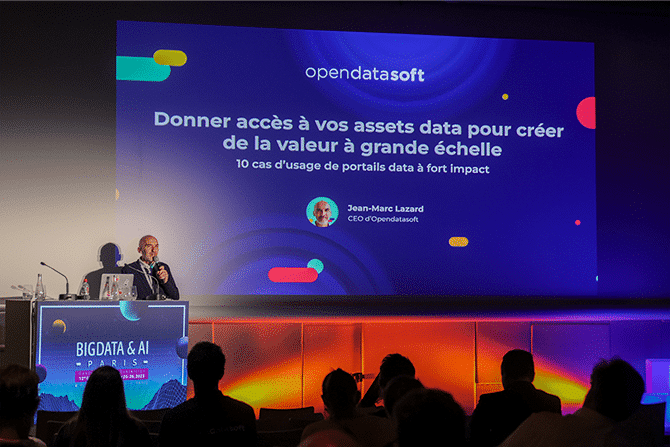Unlock large-scale value by opening access to your data assets

What motivates organizations to embark on a data portal project? How do they implement data portals? What are the expected benefits of a data portal and what functions should it have?
For the past 12 years, Opendatasoft has been helping large public and private organizations around the world to democratize the consumption of their data by as many people as possible. We help them to create value within their organization and their wider ecosystem, thanks to our data portal solution.
Now, we see that the role of data within organizations and society is changing fundamentally. New requirements are emerging around the consumption of data, which, as the digitization of our economies increases, is being mass-produced on a daily basis. Data managers within organizations must find solutions to meet the new data access needs of employees, partners, customers and the public alike.
What motivates organizations to embark on a data portal project? How do they implement data portals? What are the expected benefits of a data portal and what functions should it have?
Data strategies to create value at scale
In January, we published a survey of 500 leaders of large organizations, to find out how the issue of data, and data management in particular, fitted into their strategy.
Unsurprisingly, 85% of respondents considered data management to be one of their top priorities for creating value at scale within their organization. Decision-makers are aware that this is not a question of overhauling data management tools, but rather of transforming how they use and manage data.
There’s a simple reason for this focus on data management. Leaders can all see the benefits of enhancing how they use data – increased efficiency and lower costs, higher revenues, improved risk management and improved stakeholder relations.
The implementation of data management solutions has therefore become essential if we are to seize opportunities to create value from the current exponential increase in data volumes.
Last but not least, the uses to which data is put are constantly evolving, with a growing demand within organizations for analytics and information that adds value to operational activities.
Decision-makers are well aware of the strategic importance of data, and this is prompting them to embark on a process of data democratization.
How data-mature are organizations?
Despite recognizing the advantages, our survey found that only 21% of organizations are truly data-centric – that they have a strong data culture, mature data governance resources and strong data tools. These organizations have the commitment of CEOs and company boards, a defined data strategy, a clear roadmap, healthy budgets and an organization-wide data culture.
33% of organizations are classed as “conventional”, predominantly in the private sector and organizations with more than 5,000 employees. These have dedicated data functions and employee training programs around data, but are still reluctant to share useful data with everyone.
24% of organizations are “at the crossroads”. They are more numerous in the public sector and in large companies that are not digital natives. Decision-making is still very vertical, and the skills needed to share data have not been recruited or delivered through training.
Finally, 22% of organizations are classed as “non-committed” and do not use data as a priority in their development. They are largely based in the health and social services sector, and in companies with 50 to 249 employees.
Our study also highlights the obstacles to data transformation at scale, with the problem of access to data being the primary challenge. Decision-makers also point to difficulties in creating a data culture internally, and in establishing an effective governance strategy. These weaknesses hinder the scalability and industrialization of data use cases, as well as the expected creation of value.
What is the role of the Chief Data Officer or other leaders responsible for data at corporate level in overcoming these obstacles?
Access to data assets: the key to creating value at scale
Data access is central to a successful data strategy that is focused on creating value at scale. It must be simple, secure and industrialized. In other words, it must cover everyone in the organization, and involve data assets and data of all kinds. These three pillars (simple, secure and industrialized), provide the means to accelerate the governance, quality and democratization of data, enabling organizations to scale their programs.
By data assets we mean data that has been transformed to make it usable and reusable by a business. Raw data, such as from an ERP software solution, is not a data asset. However, as soon as this data is prepared, described and put into a standard format that makes it reusable by all, it becomes a data asset. Assets can range from a CSV file to a standard API or visualization, or even an algorithm or set of metadata schemas that allow data to be reused by the greatest number of people.
Sharing data effectively requires a data portal. This is a data management solution that adds value to data creation and storage solutions (such as data lakes, or data warehouses), integration tools, virtualization tools, data processing tools, or solutions that enable data analysis (such as business intelligence and data science tools). The data portal unifies the search, exploration and reuse of all the data assets created with these different tools. It then makes it possible to consume all the resources created and stored in these other parts of your data management stack.
Industrializing and democratizing access to data assets: the data portal as a driver for growth
The “last mile of data” is all too often neglected by organizations. However, setting up a secure, one-stop shop that allows people to quickly discover and use all of an organization’s data assets is essential. It enables everyone to easily search, browse and reuse reliable data to create value.
Opendatasoft is a data portal solution that makes data assets accessible throughout the organization. For CDOs, CIOs or data managers, the data portal is a key solution to enable success. As a one-stop-shop it provides self-service access to data assets for the maximum number of stakeholders, whether in-house or with external public or private audiences.
In terms of our technology, it provides the twin abilities of enabling better portal administration for data managers, while also creating accessible experiences and providing a seamless experience for portal users.
Functionalities included in the Opendatasoft data portal include:
- Connectivity and interoperability with the organization’s entire data and tech stack
- Metadata preparation and management functions. These can be carried out within the solution or by retrieving information from external solutions, such as data catalog tools
- Multilingual. This is essential to share data, particularly across countries and regions
- Workspace creation. This enables organizations to set-up sub-portals that provide specific spaces for different departments, still accessed through exactly the same solution. This effectively provides users with the chance to interact with and consume data in ‘read-only’ mode, without modifying it at source.
All these features demonstrate that a data portal solution shares many capabilities with a content management system (CMS). It is essentially centered on the ability to create uses around your data, such as by highlighting potential use case examples and providing training resources such as tutorials.
Sharing functionalities are also essential, whether in the form of APIs, downloads or reuse. This is crucial to creating value. The portal must therefore be able to manage rights and resources to guarantee data security and confidentiality.
Last but not least, a successful data sharing strategy requires ongoing analysis of how it is being used. What is the level of data use? What are the most popular elements of your data portal? Why and how are data assets consumed? Our usage-focused data lineage functionality provides answers to all these questions, offering a detailed analysis of data movement and reuse.
Our data portal is aimed directly at data owners who want to make their data easier to understand, discover, explore, and consume. That means that experience, search and navigation functionalities are essential to enable portal users to quickly find and interact with the data they need.
Robust technology for a wide range of uses
All these features have to be built on a technological foundation that enables them to scale. Adopting a multi-cloud solution, allows solutions to handle large volumes of data, high portal traffic and, consequently, heavy consumption of data assets. The multi-cloud approach also makes it possible to meet performance requirements, to offer access to data on every continent and, in some cases, to meet data sovereignty requirements.
The solution has to be secure, so that everyone can manage and consume data on a daily basis without risk. In particular this requires the ability to manage data access rights. It also means being able to isolate and protect particular data sets when working in more sensitive environments.
The platform must also enable data administrators and managers to deliver smoother data experiences for everyone, whatever their technical skills. This means providing the same type of experience as users receive on an ecommerce marketplace. Given that data is essentially now an easy to consume product, adopting the same user interface approach as an ecommerce website provides a seamless method of interacting with data assets. Users should find similar features to those they are familiar with when shopping online, such as the ability to add filters to search queries, contextual menus and a single search bar that provides access all of the organization’s data assets, regardless of their location.
Providing such an experience breaks down barriers to data use and creates a framework of trust. Once you have created a coherent data environment, covering both simple and advanced features, users can easily and confidently discover and interact with data. This will help develop a data culture within the organization, and position data at the heart of decision-making and operations.
Three main types of data portal to cover all needs
Over 350 organizations globally use Opendatasoft to create and maintain their data portals. These data portals fit into one of three main types, depending on their needs.
Internal data portals. These can be self-service data platforms, data marketplaces, data hubs or be used to feed specific applications and services. These portals enable organizations to reduce costs, digitize and optimize operations, increase and create new sources of revenue, manage risks and increase transparency.
Our customer, Caisse des Dépôts, launched its internal portal to make data widely accessible and spread a data culture throughout the organization. Employees can find relevant general data as well as data sets on the organization’s key focus areas, such as social housing, investment programs, and retirement. Creating this portal has increased operational efficiency, with data now accessible to all 6,000 employees. They benefit from data sets enriched to meet their specific needs, with daily automated monitoring of new data. The data portal now includes 70 datasets, with 2.2 million records, and has seen more than 4.3 million API calls over the last 12 months.
Partner/customer data portals. These enable organizations to increase and generate new sources of revenue, and create innovation in their ecosystems. These portals can be trusted spaces accessible by partners, marketplaces for commercializing data, or portals created specifically for individual customers.
Birdz by Veolia provides its 3,300 customers with customer portals to monitor the Internet of Things (IoT) sensors that it supplies. These provide customers with complete management information, thanks to interactive dashboards and data visualizations created with Opendatasoft. These transform IoT sensor data into concrete insights. By providing customized dashboards, Birdz by Veolia is able to differentiate itself from its competitors. Using Opendatasoft’s “Dashboard as a Service” capabilities has enabled Birdz to quickly create and deploy dashboards across its customer base.
Open data portals. These enable organizations to manage risk and increase transparency, improving engagement with citizens and consumers. Ministries, local authorities, energy companies and private businesses all open their data through this type of portal, engaging users through data visualizations, dashboards, maps and data stories.
Since 2014 French railway operator SNCF has been making its data accessible on a large scale through its open data portal. This brings together open data from the holding company and its three subsidiaries (which cover passengers, rail network and stations & connections). The portal is connected to the organization’s information systems, which provide data from a wide variety of sources, from FTP access to data warehouses to storage tools. The portal also enables SNCF to better manage its data roadmap, as administrators can easily see which data is most popular, and which types of use and reuse are most in demand.
Through its work on data portal projects around the world Opendatasoft has built up unique knowledge around how to successfully create data portals and make usable information available at scale. Today, we operate more than 3,000 portals for 350 customers in 25 countries across every continent, working with enterprises, local administrations and central government departments. Want to launch your own data portal? Get in touch with one of our experts to learn how.
 Data Trends
Data Trends
How successful are governments at sharing their data with citizens and businesses? The latest Open Data Maturity report provides an overview of progress across Europe, and highlights the importance of improving data portals and measuring impact to future success

Data drives effective, well-functioning smart cities and helps build local ecosystems that bring together all stakeholders to meet the needs of the entire community. However, sharing data between stakeholders can be difficult - based on recent Gartner research we explain how urban data exchanges transform smart city data sharing.

